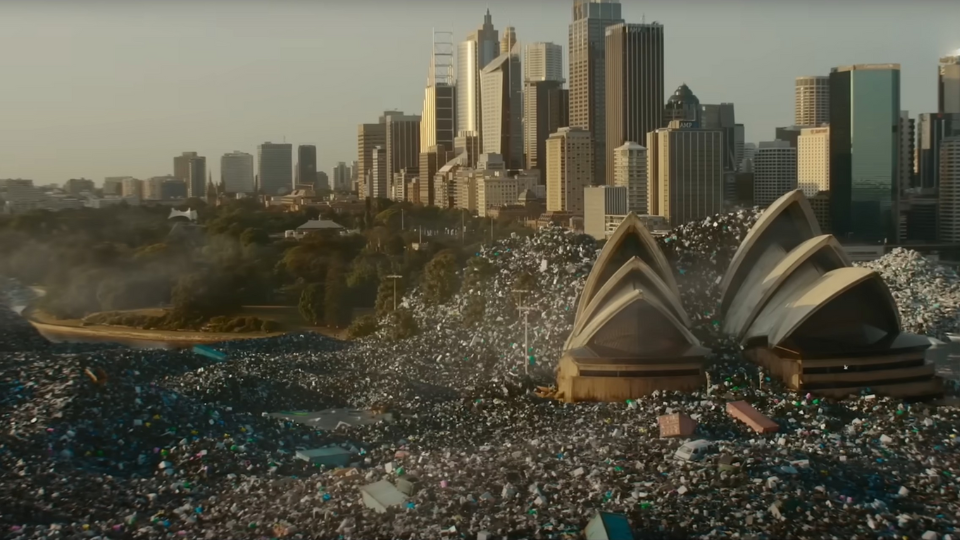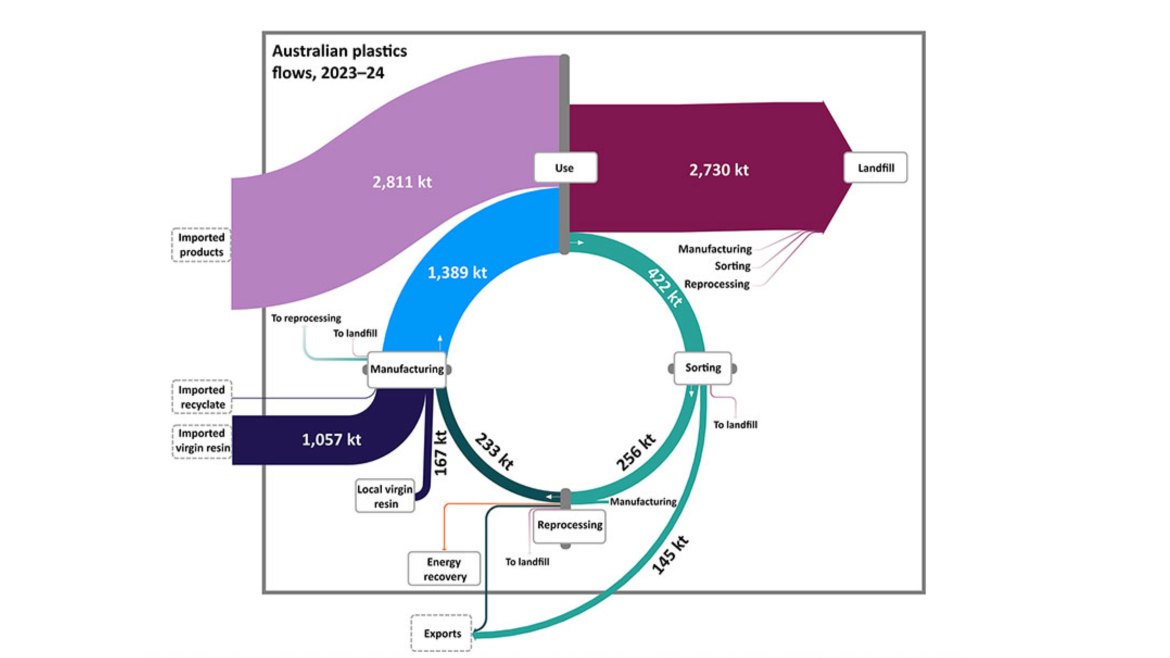Australia’s Plastic Problem Needs Bold Policy & Big Ideas

Still from 'Buy Now! The Shopping Conspiracy' documentary

4 million tonnes of plastic consumed, 3.87 million tonnes of which was imported. Only 233,000 tonnes recycled back into Australian manufacturing.
Of the 3.1 million tonnes that reached end of life:
- 1.2 million tonnes (39%) packaging related
- 1.5 million tonnes (47%) non-packaging applications
- 0.4 million tonnes (14%) unknown applications.
2.7million went to landfill*
14% Is the recycling rate for plastics in Australia
The DCCEEW just released its annual Australian Plastics Flows and Fates (APFF) report, and it paints a grim picture of the scale of Australia’s plastics problem. We consumed 4 million tonnes of plastic last year, 3.87 million tonnes of which was imported material that has become waste in our local systems.
By 2029, it is predicted that we will have a plastics reprocessing gap of 2.4 million tonnes, and that is if we are using reprocessing facilities to their full capacity. Which, spoiler alert, we’re not. This presents a significant disconnect to be addressed in both our manufacturing and recovery systems, but also highlights our urgent need for regulation.
Despite reprocessing capacity doubling from 2023 to 2024, (305 kt - 600 kt) our plastic reprocessing rates have barely increased, in 2024 we funnelled only 233 kt of recycled plastic back into local manufacturing, and 145kt was sent overseas, using only 50% of the available reprocessing capacity!
Thankfully there has been some targeted effort to utilise some of this capacity, primarily focused on how we get soft plastics into the right systems, with organisations such as Soft Plastic Stewardship Australia, Oscar Nicholson and iQRenew leading the charge. These are critical steps in the right direction, but assuming this all goes to plan and recycling capacity doubles over the next 5 years as expected, assuming we optimise everything, we still have a massive gap to address.
Earlier this year, AusPost launched their POLLASTIC mailer bags, which are made from recycled plastic sourced from Southeast Asia. Whilst this plastic is collected from coastal regions and would otherwise end up in the ocean, the Australian Council of Recycling (ACOR) correctly pointed out that this is a huge missed opportunity for a major Australian business to invest in our domestic circular economy.
In the UK, you are required to pay a plastic tax of £224 for every tonne of plastic that contains less than 30% recycled material. The UK additionally introduced an EPR scheme which includes plastics and other packaging materials. Early signs indicate that this is moving the needle, and significantly it has created significant behavioural change, as companies embed reduction in the design process to minimize and optimize materials to avoid additional cost!
France has taken this a step further by announcing that, from 2026, it will be rewarding producers using locally recycled plastics with incentives up to €1000 per tonne of material. This is a radical move, but it is a meaningful commitment to the idea of circularity with intent.
Just for fun…If you take the APCO proposed consumer education budget of $63 million and invested it back into the Australia Circular economy, using the same incentive France has announced, that equates to 35,000 tonnes of recycled content over the next 5 years. ($1790/tonne, direct comparison to France).
Subsidy at-scale, delivered consistently, for an extended period of time, shows intent and will drive innovation, investment and circularity in Australia.
Off Take Matters
What if, as an extension of that approach, Australia also introduced off-take deals with global suppliers, incentivising them to include Australian plastic recyclate in their products. I had a look at the Top 10 products imported to Australia and picked out computers from that list. With $10.46 billion in imports, computers bring in 36,000 tonnes of plastic each year. What if every computer imported into Australia had to include 50% of Australian recycled plastic, reducing both the net inputs and outputs into our recycling system?
EPR… that’s another approach Australia might consider, a proven system that rewards good actors and penalises those that stay stationary. We have talked a lot about this at Phantm, and will continue to do so.
These might seem like radical steps, but we need some wild ideas to slow the flow of plastic and let the systems catch up. In fact, we need to do all of these things!

This graph illustrates the stark reality of the circularity challenge. It is very unlikely, based on the data presented, that Australia can create a Circular Economy for plastics without some radically BIG ideas!
Reduction
Reducing the amount of materials we place into our ecosystem is an obvious 1st step. EPR regulation will ultimately be the vehicle that drives this intent, but many businesses have already started.
My work at Phantm is often inspiring. Our customers are driven by good intent, they want to do better, they are anticipating the future and addressing the clear challenge we face today. Capturing packaging data enables optimisation, reduction before it becomes waste, simplifying materials to support recovery and downstream recycling, more often than not saving cost!
I am a plastics guy, a packaging nerd, I am not allowed to go to a supermarket unaccompanied, because I arrive home with 'cool packaging' stuff and no food we need!
But I am clear, and I think it is clear, that if we wait and hope for change, it won't come. We need action, we need regulation, we need some big ideas!
Thanks Francesca Puleio for your input.
Say hello to Phantm's Packaging AI for instant insights
Just drag and drop an image of your packaging to instantly see what it’s made of, where you can save costs, how to reduce waste, and spot compliance risks.













